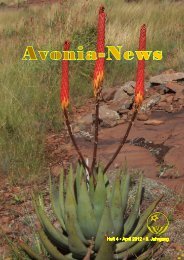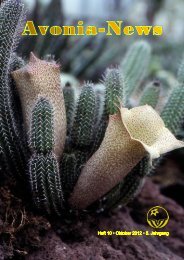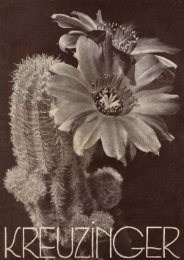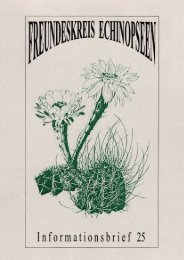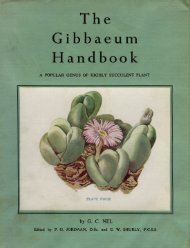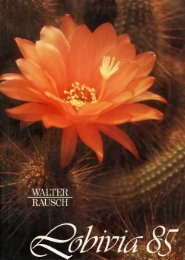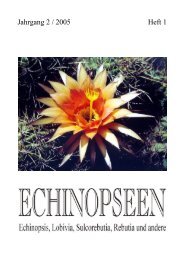journal
journal
journal
You also want an ePaper? Increase the reach of your titles
YUMPU automatically turns print PDFs into web optimized ePapers that Google loves.
THE<br />
CACTUS<br />
AND SUCCULENT<br />
JOURNAL<br />
OF GREAT BRITAIN<br />
ESTABLISHED 1931<br />
Vol. 13 APRIL, 1951 No. 2<br />
EDITORIAL<br />
It may not be generally known that your editor deals with cactus queries sent to "Amateur Gardening."<br />
The season usually provides a continuous stream of questions to be answered and, certainly, some of them are<br />
really interesting. A gardening paper has to provide a service of this nature and has to depend on outside specialists<br />
in the case of the lesser known plants.<br />
I am continually receiving plants in various stages of decay and mush, and the enquirers consistently want to<br />
know why it should be so, their letters reveal a wonderment after they have received, in the writer's point of view,<br />
the best of treatments.<br />
Within the last few days (in March), I received several cuttings of Epiphyllum hybrids (Phylhcacti) in various<br />
stages, some actual mush. The enquirer wanted to know what was wrong and how to avoid it. As all know,<br />
March was continuing the cold, frosty, rainy weather we have been having for some time. The tips of the " fronds "<br />
were decayed and, in my opinion, had been in too close contact with the glass in frosty weather. At the same time,<br />
the bases of the cuttings were mushy, too. This was not so obvious, or would not have been, had only cuttings<br />
been sent, but there were masses of loose roots, soil, etc. The soil was greatly in the minority.<br />
In one mass of roots I found a spongy, wet mass out of which I could actually squeeze a quantity of water !<br />
This gave me a clue which I could not fail to follow up. I quote from this instance because it is a condition<br />
that is met with all too frequently, especially with those who only have one or two plants and the same fault is<br />
very prevalent among more experienced collectors.<br />
Plants that grow quickly and large, like Epiphytlums, soon fill up the pot and exhaust the soil, and finally, the<br />
roots are more numerous than soil, and what soil remains, usually mainly at the top, becomes caked and impervious<br />
to watering, which just remains on the top and never penetrates the lower portions in the pot. In this case, the<br />
plant does not get sufficient water, and the tips of the " fronds " get none and, in consequence, wither and become<br />
yellow. As the water cannot penetrate, the base of the plants, usually a dense mass of shoots, becomes a quagmire.<br />
It can easily be imagined the state of affairs when the plant is subject to frosty weather and that the plant is cut off<br />
at the base into a mushy mass.<br />
The obvious remedy is not to let your plants become bound with roots and exhaust the soil. All " leafy "<br />
plants should be continually kept under review and re-potted in fresh soil at the first sign of the undesirable condition<br />
especially when roots come through the drainage hole. This also applies to free growing succulents, Opuntias, etc.<br />
And, once again, the oft repeated advice of Mr. Boarder—never water your plants in frosty weather.




